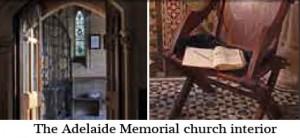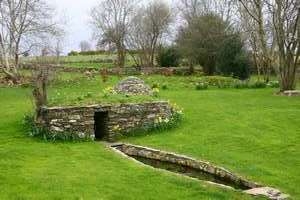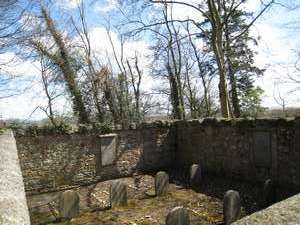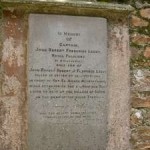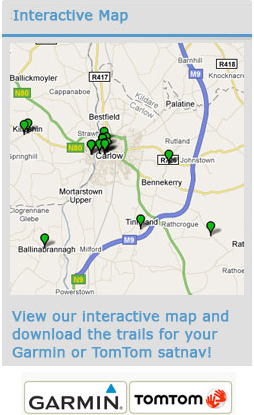Sites
Adelaide Memorial Church
Adelaide Memorial Church
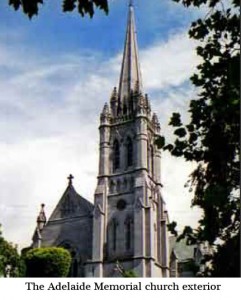 11. Adelaide Memorial ChurchThis church was raised by John Duguid of Dover, England, in memory of his wifeAdelaide and his daughter Constance who was killed in a riding accident whilevisiting friends in Myshall. Described as an architectural gem, it was designedby George Coppinger Ashlin, one of the foremost architects in the country as aminiature of Salisbury Cathedral in England. It stands in beautifully maintainedgrounds, accessed by a yew-lined drive.
11. Adelaide Memorial ChurchThis church was raised by John Duguid of Dover, England, in memory of his wifeAdelaide and his daughter Constance who was killed in a riding accident whilevisiting friends in Myshall. Described as an architectural gem, it was designedby George Coppinger Ashlin, one of the foremost architects in the country as aminiature of Salisbury Cathedral in England. It stands in beautifully maintainedgrounds, accessed by a yew-lined drive.Cranavane – Crann an Bháinin
Set in an untouched rural landscape the 12. holy well at Cranavane is closely associated with the early medieval Barragh church, the ruins of which lie some 400 metres to the west. This church was linked with St. Finian who was born nearby in Myshall. In front of the well there is a trough in the shape of a coffin where apparently it was the custom to dip coffins before burial in Barragh graveyard. The well itself is roofed and enclosed apart from its opening on the south side.
The waters of the well are believed to cure a range of ailments including soreness of the eyes, pains and hurt limbs. People from the surrounding area come to the well, particularly in the month of May. The Patron or Pattern day![]() on May 3rd attracts many visitors.
on May 3rd attracts many visitors.
In the nineteenth century large gatherings at the well could sometimes become rowdy and drunken, leading to the suspension of visits. Nowadays the recently restored well and its surrounding area offer a haven for those seeking peace and tranquillity.
Admission: Free
Parking: Limited
![]() Pattern day: Day on which graves are visited and mass celebrated in graveyards.
Pattern day: Day on which graves are visited and mass celebrated in graveyards.
Holy Well at Cranavane
holy well at Craholy well at
Set in an untouched rural landscape the holy well at Cranavane is closelyassociated with the early medieval Barragh church, the ruins of which lie some 400 metresto the west. This church was linked with St. Finian who was born nearby in Myshall. Itwas the custom to dip coffins in the water of the well before burial in Barragh graveyard.
The waters of the well are believed to cure a range of ailments including soreness of theeyes, pains and hurt limbs. People from the surrounding area come to the well, particularlyin the month of May. The Patron or Pattern day on May 3rd attracts many visitors.
In the nineteenth century large gatherings at the well could sometimes become rowdy anddrunken, leading to the suspension of visits. Nowadays the recently restored well and itssurrounding area offer a haven for those seeking peace and tranquillity.
 Open: Daily, daylight hours | Admission: Free | Parking: Limited9 Directions to the next site: From Cranavane follow the R724 to Kildavin Village and from there follow signs for N80 toCarlow through the village of Ballon. The Quaker graveyard and Lecky family graveyard are on the outskirts of Ballon Village on theleft hand side of the road. Distance 13km.
Open: Daily, daylight hours | Admission: Free | Parking: Limited9 Directions to the next site: From Cranavane follow the R724 to Kildavin Village and from there follow signs for N80 toCarlow through the village of Ballon. The Quaker graveyard and Lecky family graveyard are on the outskirts of Ballon Village on theleft hand side of the road. Distance 13km.
Ballykealey – Baile Uí Chaollaí – O’ Kealy’s town
13. Quaker graveyard and Lecky family graveyard – The charming village of Ballon is rich in archaeological heritage. Located on the outskirts of the village is the Quaker graveyard also strongly associated with the Lecky family for whom nearby Ballykealey House was built in 1830. Twenty six members of the family are known to be buried in this Quaker ![]() plot.
plot.
By the late nineteenth century most of the family had become members of the Church of Ireland and a new family graveyard was consecrated in 1880. The graveyard remained in use until 1950. It includes a memorial to Captain John Lecky, killed in Mesopotamia in 1915 and the grave of Molly Grace (nee Lecky) a section officer in the WAAF who was killed in 1942 while flying her plane during the Second World War.
Admission: Free
Parking: Limited
![]() Quakers: Popular name for a group of Christians who use no scripture and believe in a simple, pacifist lifestyle. They call themselves The Society of Friends.
Quakers: Popular name for a group of Christians who use no scripture and believe in a simple, pacifist lifestyle. They call themselves The Society of Friends.
Quaker graveyard and Lecky family graveyard
Quaker graveyard and Lecky family graveyard
